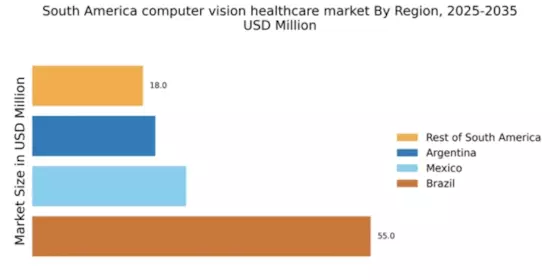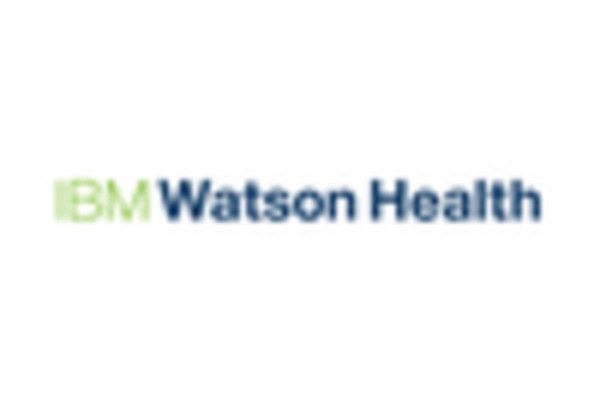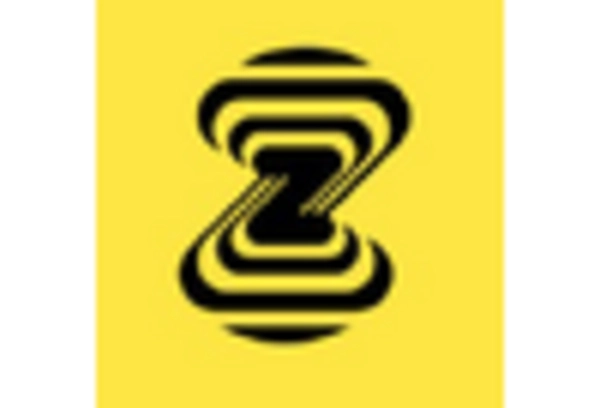Growing Focus on Preventive Healthcare
The computer vision-healthcare market in South America is influenced by a growing focus on preventive healthcare. As awareness of health issues rises, there is a shift towards early detection and prevention strategies. This trend is reflected in the increasing use of computer vision technologies for screening and monitoring purposes. For instance, the market for AI-driven diagnostic tools is expected to reach $500 million by 2027, indicating a robust growth trajectory. Preventive healthcare initiatives, supported by government programs, are likely to drive the adoption of computer vision solutions in various medical fields, including dermatology and ophthalmology. This emphasis on prevention not only enhances patient outcomes but also reduces long-term healthcare costs, thereby fostering a conducive environment for the computer vision-healthcare market.
Investment in Healthcare Infrastructure
Investment in healthcare infrastructure is a critical driver for the computer vision-healthcare market in South America. Governments and private entities are increasingly allocating funds to modernize healthcare facilities, which includes the adoption of advanced technologies. For example, Brazil has announced a $1 billion investment plan aimed at enhancing healthcare services, which includes the integration of computer vision technologies. This investment is expected to improve diagnostic capabilities and patient care. Additionally, the establishment of new hospitals and clinics is likely to create a favorable environment for the deployment of computer vision applications, such as automated image analysis and telehealth solutions. Consequently, the computer vision-healthcare market is poised for growth as infrastructure improvements facilitate the adoption of innovative technologies.
Rising Demand for Enhanced Imaging Solutions
The computer vision-healthcare market in South America is experiencing a surge in demand for advanced imaging solutions. This demand is driven by the increasing prevalence of chronic diseases, which necessitate accurate and timely diagnostics. For instance, the market for medical imaging is projected to grow at a CAGR of approximately 8.5% from 2025 to 2030. Enhanced imaging technologies, such as MRI and CT scans, are becoming essential tools in hospitals and clinics, facilitating better patient outcomes. Furthermore, the integration of computer vision technologies into imaging systems is expected to improve diagnostic accuracy, thereby attracting investments from healthcare providers. As a result, the computer vision-healthcare market is likely to expand significantly, reflecting the urgent need for innovative imaging solutions in the region.
Technological Advancements in AI and Machine Learning
Technological advancements in AI and machine learning are significantly impacting the computer vision-healthcare market in South America. The rapid evolution of these technologies is enabling the development of sophisticated algorithms that enhance image analysis and interpretation. For example, AI algorithms can now detect anomalies in medical images with accuracy rates exceeding 90%. This capability is particularly valuable in radiology, where timely and accurate diagnoses are crucial. As healthcare providers increasingly recognize the benefits of integrating AI into their workflows, the demand for computer vision solutions is expected to rise. Moreover, collaborations between tech companies and healthcare institutions are likely to accelerate innovation, further propelling the growth of the computer vision-healthcare market in the region.
Increasing Collaboration Between Tech and Healthcare Sectors
The computer vision-healthcare market in South America is experiencing an increase in collaboration between technology firms and healthcare providers. This trend is driven by the recognition that partnerships can lead to the development of innovative solutions that address pressing healthcare challenges. For instance, joint ventures between software developers and hospitals are facilitating the creation of tailored computer vision applications that improve diagnostic processes. Such collaborations are expected to enhance the efficiency of healthcare delivery and patient management. Furthermore, as more tech companies enter the healthcare space, the competition is likely to spur advancements in computer vision technologies. This collaborative environment is anticipated to foster growth in the computer vision-healthcare market, as stakeholders work together to leverage technology for better health outcomes.


















Leave a Comment